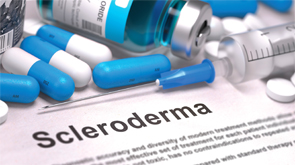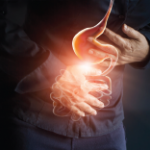
Nine out of 10 scleroderma cases include clinical signs of GI involvement.
Tashatuvango/shutterstock.com
CHICAGO—Nine out of 10 scleroderma cases include clinical signs of gastrointestinal (GI) involvement, with severe involvement associated with high mortality rates, but the pathology of this is not very well understood, a GI expert said at the ACR’s State-of-the-Art Clinical Symposium.
That has left clinicians with a slate of treatments—anti-reflux, antimicrobials and prokinetics—that address only the symptoms, some with more effectiveness than others, and some with more side effects, said John O. Clarke, MD, clinical director of the Johns Hopkins Center for Neurogastroenterology.
In scleroderma, the GI tract is the most commonly involved system, other than the skin, with the esophagus most commonly affected. Typical symptoms in scleroderma patients range widely, including dysphagia, heartburn, regurgitation and nausea, abdominal pain, diarrhea, constipation and incontinence. Other rheumatic diseases can also have varied involvement, but it tends to be less widespread, Dr. Clarke said.
GI involvement is the presenting feature in just 10% of scleroderma cases, but autopsies have found involvement in 94%. Severe involvement has been found in only about 8% of cases, but just 15% of those patients survive more than nine years, and GI involvement is the third-leading cause of mortality in scleroderma.
A four-stage process of GI involvement has been proposed, with an early vascular lesion followed by neural dysfunction, and then smooth muscle atrophy followed by smooth muscle fibrosis. But autopsies have found that smooth muscle atrophy is found more commonly in these patients than fibrosis, refuting the theory.

Dr. Clarke
“This is controversial,” Dr. Clarke said. “The bottom line is that it’s not entirely certain that this four-stage [process] is correct.”
Dysmotility is the main manifestation, with poor propulsion of food through the gut.
“I do think that dysmotility is so frequent in these patients that, if you see someone who comes in with characteristic symptoms, it’s very reasonable to treat them up front,” Dr. Clarke said.
Treatments
The main lifestyle changes for reflux are stopping smoking, avoiding alcohol, elevating the head at least two inches when sleeping and not eating within three hours of sleeping. Avoiding certain foods can have different effects in different people, Dr. Clarke said.
The most effective medical treatment is proton-pump inhibitors, which take longer to start working but are longer acting. Prokinetics that strengthen the lower esophageal sphincter are another option, but only metoclopramide is FDA approved. Other treatments, including the 5HT1-receptor agonist buspirone, are emerging, Dr. Clarke said.
For gastric involvement, a chief adjustment is to eat the same number of calories, but over five or six meals instead of three. And, for the small bowel, the idea is to avoid gas-producing foods, such as lactose, fructose and wheat, and high-sugar foods.
The somatostatin analogue, octreotide, and the acetylcholinesterase inhibitor, pyridostigmine, are two additional prokinetic options for the small bowel.
Antibiotics are also an option but, Dr. Clarke said, “there are no guidelines as to which ones you use, how long to use them, which cycle to do.” His approach is to try ciprofloxacine, metronidazole or rifaximin for two weeks, then decide on how frequently to rotate them, and whether to incorporate an antibiotic-free period, based on the clinical response.
For the colon, treatments include osmotic laxatives; lubiprostone to stimulate chloride secretion, although it comes with “pretty significant” nausea effects; and linaclotide to stimulate fluid secretion.
Referral & Tests
Dr. Clarke said a patient should be referred to a gastroenterologist if a clinical presentation is unusual, if a patient isn’t responding to typical treatment, if there is a concern about complications or if there is a need for a procedure.
There is some belief that an endoscopy should be done relatively early in these patients, in part because of a heightened risk of Barrett’s esophagus, which in most patients is about a 12% risk. Dr. Clarke noted, though, that such a risk is “not terribly different from all comers.” There is also a high prevalence of strictures, reflux esophagitis and a concern that symptoms might not well represent the findings from an endoscopy.
A four-stage process of GI involvement [in scleroderma] has been proposed, with an early vascular lesion followed by neural dysfunction, & then smooth muscle atrophy followed by smooth muscle fibrosis. … Dysmotility is the main manifestation, with poor propulsion of food through the gut.
There has also been a case made for early manometry, because of an association between esophageal dysmotility and lung disease, although Dr. Clarke said this supposed benefit is controversial as well.
When medical treatment fails, physicians can turn to barium studies, endoscopy, manometry and formal reflux testing.
“We have a number of tools that we can use to better define what’s going on with both movement and reflux, and then hopefully take that information and try and customize what patients are on at that point,” Dr. Clarke said.
Questions Remain
Several important questions in the area of dysmotility and autoimmune disorders beg to be answered, he said—including whether GI involvement progresses with time, whether there are clinically distinct subsets, whether early treatments prevent GI complications, how the microbiome is involved and, most importantly, what the underlying cause is.
“If there were a way to really reverse that and really modify the underlying mechanism,” Dr. Clarke said, “I think we’d be in a much different situation.”
Thomas R. Collins is a freelance medical writer based in Florida.


